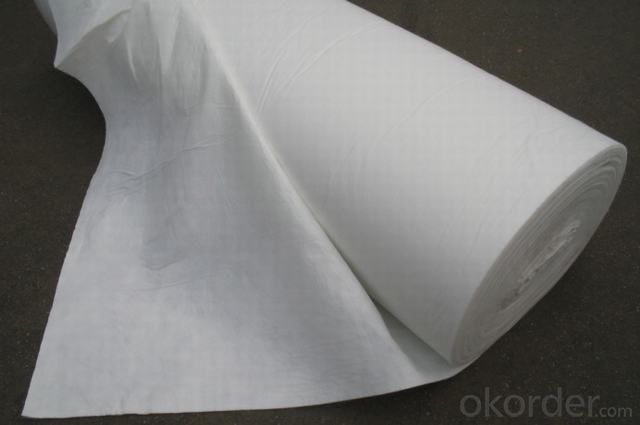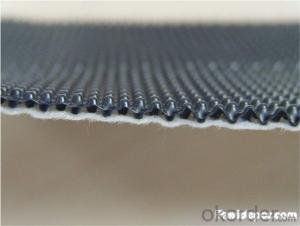Geotextile Gazon for Construction - Geosynthetics
- Loading Port:
- Qingdao
- Payment Terms:
- TT or LC
- Min Order Qty:
- 20000 m²
- Supply Capability:
- 1500000 m²/month
OKorder Service Pledge
OKorder Financial Service
You Might Also Like
1.Advantage and function of Geotextile as one type of Geosynthetics
Good flexibility,permeability,filtration,separation and easy for construction
1) Filtration
The filtration layer of the dykes, river canal, seacoast, concrete slope, retaining walls. At the same time of preventing the clay granule from passing, it allows the water and the gas pass through freely.
2 )Separation:
The isolation of the railway dregs and the roadbed, roadbed and the soft base, surface of the airdrome and parking lot and the groundsill, different dam materials. It isolates the soil and the gravel of two kinds different granule pathway from the groundsill or other buildings.
3) Adding muscle:
The highway, railway, soil-stone dam, breakwater, airport, backfill soil of retaining wall, slope protection, etc in which distributes the earth stress, prevents the side-displacement of the earth body and improves the earth body stability.
4 )Protection
It prevents the dam from being washed out, protects the dam and the bottom, prevents the water and soil from being washed away.
2.Usage:
Used in the area of highway,railway,dam,reclamation etc.for filtration separation drainage and protection.
3.Size of package
Width is 1-8m,length is 50-100m,or pack as client request
2.Specifications of Geotextile as one type of Geosynthetics
1) Weight / Mass: 100g/m2-1500g/m2
2) Width: Within 8 m (1m-8m)
3) Length: 50m-100m/roll (as request)
4) Material: PP / PET
5) Color: Black , white , grey and other color
6) Certificate: CE/ISO9001 , ISO14001
7) Manufacturing method: nonwoven / woven
8) The Biggest geotextile manufacturer/factory in China for many years
3. Technical Data Sheet of Geotextile as one type of Geosynthetics
PET continuous filament spunbond needle punched nonwoven geotextile(representative average data.) | |||||||||
Test Item/Unit/No. | HY100 | HY150 | HY200 | HY250 | HY300 | Test Method | |||
Mechanical Properties | |||||||||
Tensile Strength | CD | kn/m | 4.8 | 8.3 | 10.9 | 14.5 | 18 | ASTM D 4595 | |
MD | 7 | 12 | 14 | 18 | 22 | ||||
Elongation at maximum load | CD | % | 65 | 64 | 63 | 62 | 61 | ||
MD | 64 | 63 | 62 | 61 | 60 | ||||
Grab Strength | CD | kn ≥ | 0.36 | 0.58 | 0.87 | 1.08 | 1.35 | ASTM D 4632 | |
MD | 0.42 | 0.78 | 1.07 | 1.33 | 1.6 | ||||
Grab Elongation | CD | % | 55 | 55 | 59 | 59 | 60 | ||
MD | 50 | 50 | 51 | 51 | 53 | ||||
Trapezoidal Tear | CD | kn ≥ | 0.16 | 0.23 | 0.31 | 0.39 | 0.46 | ASTM D 4533 | |
MD | 0.245 | 0.31 | 0.42 | 0.46 | 0.55 | ||||
Burst Strength-CBR plunger method | kn ≥ | 0.85 | 1.47 | 2.3 | 2.8 | 3.3 | ASTM D 6241 | ||
Puncture resistance | n ≥ | 220 | 320 | 430 | 540 | 650 | ASTM D 4833 | ||
Mullen Burst | Mpa | 1.2 | 1.8 | 2.3 | 2.8 | 3.3 | ASTM D 3786 | ||
Cone drop resistance(hole-Φ)Dynamic perforation diameter | mm | 34 | 30 | 26 | 22 | 19 | BS EN 918-1996 | ||
Hydraulic Properties | |||||||||
Flow Rate,Q100 | L/s/m² | 200 | 210 | 180 | 150 | 140 | ASTM D 4491 | ||
Permeability | cm/s | 0.48 | 0.43 | 0.39 | 0.36 | 0.34 | |||
Apparent Opening Size O95 | mm ≤ | 0.13 | 0.12 | 0.12 | 0.11 | 0.11 | ASTM D 4751 | ||
Apparent Opening Size O90 | mm ≤ | 0.12 | 0.11 | 0.11 | 0.1 | 0.1 | |||
Physical Identification Properties | |||||||||
Thickness 2KPa | mm | 1.1 | 1.3 | 1.8 | 2.5 | 2.9 | ASTM D 5199 | ||
Mass per unit area | g/m² | 100 | 150 | 200 | 250 | 300 | ASTM D 5261 | ||
Width | m | 2/3/6/ | 2/3/6/ | 2/3/6/ | 2/3/6/ | 2/3/6/ | |||



Pond Liner and Geomembrane Lining Systems - Once known as "flexible membrane liners", geomembranes encompass a broad group of products with distinctive properties and advantages in a multitude of uses as liners for pond lining, landfills, waste water ponds, floating covers, tanks, leach pads, reservoirs, lagoons, barriers, caps, secondary containment - application use is bounded only by the imagination.
What are Geomembranes and Geosynthetics? - Geosynthetics is a general classification representing all man-made materials used in geotechnical engineering applications including pond liners and lake lining. Many of its products are engineered to meet specific design requirements in fluid barrier systems or are designed to enhance the properties of existing soils (physical, hydraulic or mechanical).
Geosynthetics are a Smart Alternative - The value of these products lies in their ability to partially or completely replace [non-renewing] natural resources such as gravel, sand, bentonite clay and do so at a much lower cost. The technical advantages of geosynthetics are the engineered, testable, quality monitored properties of geosynthetic products versus the often difficult to verify quality and specs of naturally occurring materials. Different geosynthetic materials can be combined in order to perform desired functions, often yielding higher "rates" than the components taken separately.
- Q: Can geotextiles be used in underground applications?
- Yes, geotextiles can be used in underground applications. They are commonly used in various underground projects such as drainage systems, embankments, roadways, and retaining walls. Geotextiles help to control soil erosion, enhance soil stability, and provide filtration and separation functions, making them suitable for underground applications.
- Q: Can geotextiles be used in rockfall protection works?
- Yes, geotextiles can be used in rockfall protection works. Geotextiles are often employed as a barrier or reinforcement material in these types of projects. They can help to prevent the displacement of rocks and soil, enhance the stability of slopes, and provide additional support to rockfall protection structures.
- Q: Geotextile in the asphalt layer under what role
- The main role is isolation, drainage. Id phone manufacturers
- Q: Application Index of Geotextile Geotextile Expressway
- Too professional, and find a happy manufacturers it
- Q: How do geotextiles help in preventing the loss of fine particles in filter layers?
- Geotextiles help in preventing the loss of fine particles in filter layers by acting as a barrier that allows water to pass through while retaining the fine particles. They provide a stable and durable structure that supports the filter layer, preventing it from dislodging or eroding. This ensures that the filter layer remains intact and effectively filters out the fine particles, reducing their loss and improving the overall performance and longevity of the filtration system.
- Q: What are the specifications for geotextiles in green roof applications?
- Geotextiles used in green roof applications typically have specific specifications such as high tensile strength to withstand the weight of the vegetation and soil, excellent water permeability to allow efficient drainage, UV resistance to withstand prolonged exposure to sunlight, and appropriate thickness to provide adequate protection for the underlying layers of the green roof system.
- Q: How do geotextiles help with vegetation establishment?
- Geotextiles help with vegetation establishment by providing a stable and favorable environment for plant growth. They prevent erosion by holding soil in place, allowing roots to establish and anchor the vegetation. Geotextiles also retain moisture and regulate soil temperature, promoting optimal conditions for seed germination and plant growth. Additionally, they protect young plants from weed competition, herbicide leaching, and wildlife damage, ultimately enhancing the success of vegetation establishment.
- Q: Are geotextiles resistant to hydraulic shear stress?
- Yes, geotextiles are designed to be resistant to hydraulic shear stress. They have the ability to withstand the forces generated by flowing water, preventing erosion and maintaining soil stability.
- Q: How do geotextiles improve the performance of foundations?
- Geotextiles improve the performance of foundations by providing reinforcement, filtration, and separation functions. They increase the load-bearing capacity of the soil, distribute the load more evenly, and prevent the mixing of different soil layers. Additionally, geotextiles help to drain excess water, control soil erosion, and protect the foundation from potential damage.
- Q: Geotextile vertical permeability coefficient to retain a few digits
- According to GB / T-1998 in the short wire geotextile permeability coefficient, K = 1.0-9.9 between, so this coefficient should be retained after a decimal.
Send your message to us
Geotextile Gazon for Construction - Geosynthetics
- Loading Port:
- Qingdao
- Payment Terms:
- TT or LC
- Min Order Qty:
- 20000 m²
- Supply Capability:
- 1500000 m²/month
OKorder Service Pledge
OKorder Financial Service
Similar products
Hot products
Hot Searches
Related keywords






























